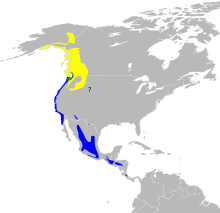 Yes. I just saw this one in the backyard of my house in a pine tree next to the bird bath But, it looks more like the photo in the Wikipedia article. It checks out because I live in it's wintering range near San Francisco.
Yes. I just saw this one in the backyard of my house in a pine tree next to the bird bath But, it looks more like the photo in the Wikipedia article. It checks out because I live in it's wintering range near San Francisco.
begin quote from:
Townsend's warbler
| Townsend's warbler | |
|---|---|
 | |
| Scientific classification | |
| Kingdom: | Animalia |
| Phylum: | Chordata |
| Class: | Aves |
| Order: | Passeriformes |
| Family: | Parulidae |
| Genus: | Setophaga |
| Species: | S. townsendi |
| Binomial name | |
| Setophaga townsendi (Townsend, 1837) | |
 | |
| Range of S. townsendi Breeding range Year-round range Wintering range | |
| Synonyms | |
Sylvia townsendi (protonym) | |
Townsend's warbler (Setophaga townsendi) is a small songbird of the New World warbler family.
Taxonomy[edit]
Townsend's warbler was formally described in 1837 by the American naturalist John Kirk Townsend under the binomial name Sylvia townsendi.[2] The type locality is Fort Vancouver on the Columbia River in the state of Washington.[3] Townsend's warbler is now placed in the genus Setophaga that was introduced by the English naturalist William Swainson in 1827.[4][5] The species is monotypic: no subspecies are recognised.[5]
Description[edit]
Townsend's warbler has a yellow face with a black stripe across its cheeks extending into an ear patch, a thin pointed bill, two white wing bars, olive upperparts with black streaks on their backs and flanks, and a white belly. Adult males have a black cap, black throat and yellow lower breast; females have a dark cap and a yellow throat. Immature birds are similar to females with a dark green cap and cheeks.
| Standard Measurements[6][7] | |
|---|---|
| length | 4.5–5 in (110–130 mm) |
| weight | 8.8 g (0.31 oz) |
| wingspan | 8 in (200 mm) |
| wing | 63.1–69.9 mm (2.48–2.75 in) |
| tail | 47.1–54 mm (1.85–2.13 in) |
| culmen | 9.9–10.8 mm (0.39–0.43 in) |
| tarsus | 18.1–19 mm (0.71–0.75 in) |
Life history[edit]
Their breeding habitats are coniferous forests with large trees on the northwestern coast of North America. Their nests are shallow cups built with grass and lined with moss. These nests are usually placed atop a branch in a conifer. The female lays 4 to 5 brown-speckled white eggs.
This bird is closely related to the hermit warbler, and the two species interbreed where their ranges overlap.[7]
Birds from Haida Gwaii migrate short distances further south on the Pacific coast. Other birds winter in Mexico, Central America, and the south-western United States.
They forage actively in the higher branches, sometimes hovering or catching insects in flight. They mainly eat insects and spiders and seeds. Outside of the nesting season, these birds forage in mixed flocks. In winter, they also eat berries and plant nectar.
The song of the male bird is a buzzed zee-zee-zee-bzz-zee, somewhat similar to that of its eastern relative, the black-throated green warbler. The call is a sharp tup.
This bird was named after the American ornithologist, John Kirk Townsend. Although Townsend is also credited with first describing this bird, he used a name chosen by Thomas Nuttall, who was travelling with him, and so sidestepped the convention against naming a species after oneselff.


No comments:
Post a Comment